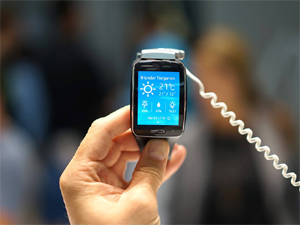



Date:20/10/16
 What if your smartwatch can help tune a guitar, displaying the note transmitted as you pluck and adjust each string? This is the future with a software upgrade that repurposes a smartwatch`s existing accelerometer.
What if your smartwatch can help tune a guitar, displaying the note transmitted as you pluck and adjust each string? This is the future with a software upgrade that repurposes a smartwatch`s existing accelerometer.
A smartwatch is capable of detecting and distinguishing a variety of taps, flicks and scratches by the hands and fingers. The new functionality makes possible new applications that use common gestures to control the smartwatch and, ultimately, other objects connected through the internet of things (IoT).
By monitoring vibrations that occur when people hold objects or use tools, the smartwatch would also be capable of recognising objects and activities, said the team from Carnegie Mellon University. "It`s as if you`re using your hand as a detection device. The hand is what people use to interact with the world," added Gierad Laput, PhD student in the Human-Computer Interaction Institute (HCII) at Carnegie.
This new technology, dubbed ViBand, was developed by Laput and Robert Xiao from the HCII`s Future Interfaces Group, along with adviser Chris Harrison, assistant professor of human-computer interaction. Normally, a smartwatch accelerometer is used to detect when a person lifts an arm so the screen can activate, or sometimes to count footsteps.
To do so, the accelerometer only needs to take measurements about 100 times a second. But when researchers increased the sampling frequency to 4,000 a second (4 kHz), they found it acted like a vibrational microphone.
"ViBand isn`t just a way to control your smartwatch," Harrison said. "It enables you to augment your arm. It`s a powerful interface that`s always available to you." A ViBand-enabled watch can tell if someone is tapping on the forearm, the palm of the hand or the back of the hand. It can detect finger flicks, scratches and other motions.
It also can sense if a person is holding various mechanical and electrical tools, such as an electric toothbrush, power drill or handsaw. Each body tap, device or activity has distinctive bio-acoustic signals. The team developed several demonstration apps for ViBand, including the use of hand gestures in the area around the watch to control apps on the watch.
The team is set to present a paper at the Association for Computing Machinery`s User Interface Software and Technology (ACM UIST) Symposium in Tokyo this week.
ViBand-enabled smartwatch can detect objects, read activities
 What if your smartwatch can help tune a guitar, displaying the note transmitted as you pluck and adjust each string? This is the future with a software upgrade that repurposes a smartwatch`s existing accelerometer.
What if your smartwatch can help tune a guitar, displaying the note transmitted as you pluck and adjust each string? This is the future with a software upgrade that repurposes a smartwatch`s existing accelerometer.A smartwatch is capable of detecting and distinguishing a variety of taps, flicks and scratches by the hands and fingers. The new functionality makes possible new applications that use common gestures to control the smartwatch and, ultimately, other objects connected through the internet of things (IoT).
By monitoring vibrations that occur when people hold objects or use tools, the smartwatch would also be capable of recognising objects and activities, said the team from Carnegie Mellon University. "It`s as if you`re using your hand as a detection device. The hand is what people use to interact with the world," added Gierad Laput, PhD student in the Human-Computer Interaction Institute (HCII) at Carnegie.
This new technology, dubbed ViBand, was developed by Laput and Robert Xiao from the HCII`s Future Interfaces Group, along with adviser Chris Harrison, assistant professor of human-computer interaction. Normally, a smartwatch accelerometer is used to detect when a person lifts an arm so the screen can activate, or sometimes to count footsteps.
To do so, the accelerometer only needs to take measurements about 100 times a second. But when researchers increased the sampling frequency to 4,000 a second (4 kHz), they found it acted like a vibrational microphone.
"ViBand isn`t just a way to control your smartwatch," Harrison said. "It enables you to augment your arm. It`s a powerful interface that`s always available to you." A ViBand-enabled watch can tell if someone is tapping on the forearm, the palm of the hand or the back of the hand. It can detect finger flicks, scratches and other motions.
It also can sense if a person is holding various mechanical and electrical tools, such as an electric toothbrush, power drill or handsaw. Each body tap, device or activity has distinctive bio-acoustic signals. The team developed several demonstration apps for ViBand, including the use of hand gestures in the area around the watch to control apps on the watch.
The team is set to present a paper at the Association for Computing Machinery`s User Interface Software and Technology (ACM UIST) Symposium in Tokyo this week.
Views: 508
©ictnews.az. All rights reserved.Similar news
- Azerbaijani project to monitor disease via mobile phones
- Innovative educational system to be improved under presidential decree
- NTRC prolongs license of two TV and radio organizations for 6 years
- Azerbaijan establishes e-registry for medicines
- Azerbaijani museum introduces e-guide
- Nar Mobile opens “Nar Dunyasi” sales and service center in Siyazan city
- International conference on custom electronic services held in Baku
- OIC secretary general to attend COMSTECH meeting in Baku
- Azerbaijan develops earthquake warning system
- New law to regulate transition to digital broadcasting in Azerbaijan
- Azerbaijani State Social Protection Fund introduces electronic digital signature
- Intellectual traffic management system in Baku to be commissioned in December
- Tax Ministry of Azerbaijan started receiving video-addresses
- World Bank recommends Azerbaijan to speed up e-service introduction in real estate
- Azerbaijan to shift to electronic registration of real estate





















